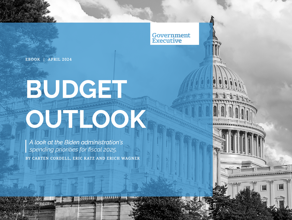White House Task Force: Agencies Need to Do More to Support Unionization in the Federal Workforce
A task force chaired by Vice President Kamala Harris and Labor Secretary Marty Walsh said that as a “model employer,” the federal government should be at the forefront of removing barriers for employees to organize or join a union.
A White House task force on Monday said that federal agencies can do a better job of fostering positive relations with federal employee unions simply by being more transparent with employees and job applicants, as well as improving communications with labor groups.
The White House Task Force on Worker Organizing and Empowerment, established via executive order last year and chaired by Vice President Kamala Harris and Labor Secretary Marty Walsh, published its first report to the president this week, although the group provided the document to President Biden last October. It contains more than 70 recommendations for federal agencies to make it easier for employees in both the federal and private sectors to organize or join a union.
As the Biden administration pushes to bolster American workers’ pay and workplace protections through better access to organized labor, the task force wrote that the federal government has a key role to play as a “model employer.”
“While some past administrations have taken individual actions to empower workers and strengthen their rights, the Biden-Harris administration will be the first to take a comprehensive approach to doing so with the existing authority of the executive branch,” the task force wrote. “Our goal is not just to facilitate worker power through executive action — it is to model practices that can be followed by state and local governments, private sector employers and others.”
Recommendations related to the federal workforce revolve around two key points. First, federal agencies should set an example for other employers by fostering a collaborative relationship with its union partners, engaging labor groups through labor-management forums before policy decisions are finalized and removing barriers from unions trying to increase membership or organize new bargaining units. And secondly, agencies should be more transparent with unions, employees and coordinate with each other to be more transparent on labor issues.
The report tasks the Office of Personnel Management with implementing a number of initiatives, including instructing agencies to provide information about whether a job opening is represented by a union and encouraging agencies to provide unions more opportunities to communicate with new hires once they report to work. OPM should also remind employees of their legal right to join and be represented by a union on a regular basis.
The task force also suggests that OPM encourage agencies to better facilitate communications between unions and employees.
“Federal sector unions have reported increasing difficulty in communicating with federal employees for a number of reasons,” the report states. “OPM should release guidance to agencies recommending different methods agencies could employ to facilitate union communications with employees, including providing unions with bargaining unit employee names and work emails and access to physical and electronic bulletin boards.”
Other priorities for OPM include updating the process for employees to become dues-paying union members and making related forms easier to use, developing training materials on unfair labor practices for managers across the federal government, and improving data transparency on federal employee union membership rates. The task force also recommended that OPM should work with agencies to review and update prior determinations about which positions should be excluded from bargaining units.
Some recommendations have already been at least partially addressed by the administration. The task force suggested that Biden rescind a 2017 executive order discouraging the use of agency labor-management partnerships, although OPM issued guidance last year stating that although the order remains intact, agencies are not prohibited from employing such forums.
And the task force recommended the administration continue its efforts to provide full federal collective bargaining rights to the workforces at the Transportation’s Security Administration and the firefighters at the U.S. Forest Service. TSA Administrator David Pekoske said last week that providing pay “equity” for his employees is his top priority for 2022.
“Unions that represent firefighters have a hard time recruiting and retaining members because of the U.S. Forest Service’s hybrid workforce, inclusive of both ‘permanent’ and ‘seasonal’ firefighters,” the report stated. “Establishing a long-term solution to the creation of a robust wildland firefighter workforce would improve their ability to carry out their mission year-round while likely increasing union density and allowing firefighters to earn a reliable income and year-round benefits, such as health care and retirement.”




